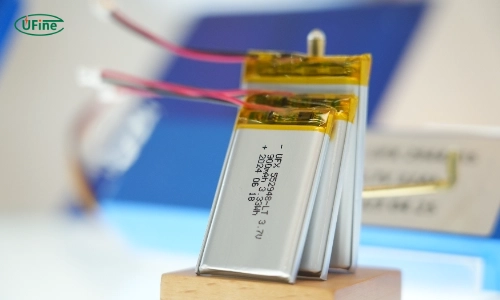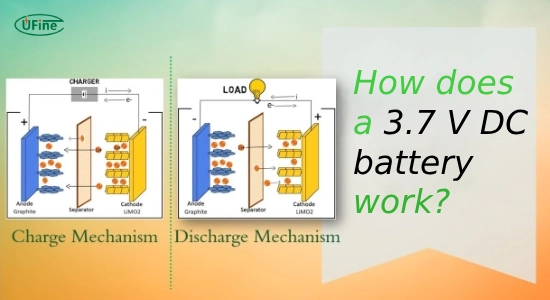In today’s tech-driven world, batteries are the unsung heroes powering our daily lives. From smartphones to electric vehicles, these power sources are essential. Among the myriad of batteries available, the 3.7 V DC battery stands out due to its versatility and efficiency. This comprehensive guide delves into everything you need to know about 3.7 V DC batteries, from their construction to their applications and maintenance.
Part 1. What is a 3.7 V DC battery?
A 3.7 V DC battery is a lithium-ion battery that typically operates at a nominal voltage of 3.7 volts. These batteries are known for their high energy density, long cycle life, and lightweight nature, making them ideal for various applications.
Part 2. 3.7 V DC battery construction and chemistry
Lithium-ion Technology
The core of a 3.7 V DC battery is its lithium-ion technology. This technology involves lithium ions moving between the anode and cathode during discharge and recharge cycles. The anode is usually graphite, while the cathode is lithium metal oxide.
Battery Components
- Anode: Typically made of carbon.
- Cathode: Made of lithium metal oxide.
- Electrolyte: A lithium salt in an organic solvent.
- Separator: A porous polymeric film that prevents the anode and cathode from touching but allows ion flow.
Part 3. How does a 3.7 V DC battery work?
When you use a device powered by a 3.7 V DC battery, lithium ions move from the anode to the cathode through the electrolyte, generating an electric current. When you charge the battery, the ions return to the anode, readying the battery for another discharge cycle.
Part 4. Advantages of 3.7 V DC batteries
High Energy Density
One of the most significant advantages of 3.7 V DC batteries is their high energy density. This means they can store much energy in a relatively small and lightweight package, making them perfect for portable electronics.
Long Cycle Life
These batteries last for hundreds of charge and discharge cycles. Long cycle life translates to better value for money and less frequent replacements.
Low Self-Discharge Rate
3.7 V DC batteries have a low self-discharge rate, meaning they retain their charge for extended periods when unused. This feature is crucial for devices that aren’t used daily but must be ready to go when required.
Part 5. Applications of 3.7 V DC batteries
Consumer Electronics
The most common application of 3.7 V DC batteries is in consumer electronics. Smartphones, tablets, and laptops all rely on these batteries for power. The high energy density and lightweight nature make them ideal for these portable devices.
Electric Vehicles
Electric vehicles (EVs) are another significant market for 3.7 V DC batteries. The high energy density and long cycle life make them suitable for the high energy demands of EVs, contributing to longer driving ranges and better overall performance.
Renewable Energy Storage
The need for efficient energy storage solutions grows as the world approaches renewable energy sources. 3.7 V DC batteries are increasingly used in solar and wind energy storage systems due to their efficiency and reliability.
Medical Devices
In the medical field, reliability and longevity are paramount. 3.7 V DC batteries power various medical devices, from portable diagnostic tools to life-saving equipment, ensuring they flawlessly operate when needed.
3.7 V DC battery real-world case studies
Consumer Electronics: Smartphones
Leading smartphone manufacturers are continually pushing the boundaries of battery technology. For instance, the latest smartphones from brands like Apple and Samsung use high-capacity 3.7 V DC batteries to provide longer usage times and support more demanding applications.
Electric Vehicles: Tesla
Tesla’s electric vehicles are a prime example of how manufacturers can scale up 3.7 V DC batteries for high-performance applications. The company’s Model S and Model X use thousands of these cells to achieve impressive driving ranges and acceleration.
Medical Devices: Portable Defibrillators
Portable defibrillators, crucial in emergency medical situations, rely on 3.7 V DC batteries for power. These batteries ensure the devices are always ready to deliver life-saving shocks when needed, highlighting the importance of reliability and long shelf life.
Part 6. How do you choose the correct 3.7 V DC battery?
Capacity
The capacity of a battery, measured in milliampere-hours (mAh), indicates how much charge it can hold. Higher capacity batteries provide longer usage times but are generally larger and heavier.
Discharge Rate
The discharge rate is crucial, especially for high-drain devices like power tools or drones. Ensure the battery can handle the required current without overheating or degrading quickly.
Size and Form Factor
Different applications require different sizes and form factors. Ensure the battery fits your device’s compartment and meets the required specifications.
Brand and Quality
Not all batteries are created equal. Opt for reputable brands known for their quality and reliability. Cheap, no-name batteries might save you money upfront but can lead to performance issues and even safety hazards.
Part 7. 3.7 V DC battery proper maintenance and care
Charging Practices
Always use the recommended charger for your 3.7 V DC battery. Overcharging or using an incorrect charger can reduce the battery’s lifespan and cause safety issues.
Storage
Store batteries in a cool, dry place. Extreme temperatures can affect their performance and longevity. If you’re storing a battery for an extended period, keep it at about 50% charge to maintain its health.
Safety Measures
Avoid puncturing or crushing the battery, leading to dangerous chemical leaks or fires. Always handle and dispose of old batteries with care according to local regulations.
3.7 V DC Battery Common Myths and Misconceptions
Memory Effect
Unlike older battery technologies, 3.7 V DC lithium-ion batteries do not suffer from memory effects. This means you don’t have to fully discharge them before recharging.
Shelf Life
While these batteries have a long shelf life, they are not immune to aging. Over time, the capacity will gradually decrease, even if the battery is not in use.
Part 8. FAQs about 3.7 V DC battery
What Are the Common Sizes of 3.7 V DC Batteries?
3.7 V DC batteries come in various sizes to fit different devices. The most common sizes include:
- 18650: This cylindrical battery, 18mm in diameter and 65mm in length, often powers laptops, flashlights, and electric vehicles.
- 14500: Similar to an AA battery, it measures 14mm in diameter and 50mm in length. Smaller devices like flashlights and some medical devices use it.
- 10440: Smaller than the 14500, it measures 10mm in diameter and 44mm in length. People use compact electronics like small flashlights and wearable tech.
- Pouch Cells: These are flexible batteries used in smartphones and tablets. They come in various dimensions depending on the device’s design.
How Do You Properly Dispose of 3.7 V DC Batteries?
Proper disposal of 3.7 V DC batteries is crucial to avoid environmental harm. Follow these steps:
- Do Not Throw in Trash: Never throw these batteries in your household trash. They contain harmful chemicals that can leak into the environment.
- Use Recycling Programs: Many communities have battery recycling programs. Look for local collection points or special recycling events.
- Retail Drop-Offs: Some retailers, like electronics stores, often have drop-off bins for used batteries.
- Mail-In Programs: Some organizations offer mail-in recycling services. You can send your used batteries to them for safe disposal.
What Are the Safety Concerns with 3.7 V DC Batteries?
3.7 V DC batteries are generally safe, but there are some risks to be aware of:
- Overcharging: Overcharging can lead to overheating and potentially cause a fire.
- Physical Damage: Puncturing or crushing the battery can lead to leakage of harmful chemicals or even explosions.
- Short Circuits: A short circuit can cause the battery to overheat rapidly.
- Storage: Storing batteries in high temperatures can degrade them quickly and increase the risk of fires.
How Can I Extend the Life of My 3.7 V DC Battery?
To get the most out of your 3.7 V DC battery, follow these tips:
- Proper Charging: Use the correct charger to avoid overcharging. Unplug the charger once the battery reaches full charge.
- Avoid Full Discharges: Lithium-ion batteries last longer if not fully discharged before recharging.
- Temperature Control: Keep the battery at a moderate temperature. Avoid exposing it to extreme heat or cold.
- Storage: If storing for an extended period, keep the battery at around 50% charge and in a cool, dry place.
What Are the Alternatives to 3.7 V DC Batteries?
While 3.7 V DC batteries are popular, there are alternatives available:
- Nickel-Metal Hydride (NiMH): These batteries use consumer electronics and power tools. They are less energy-dense than lithium-ion batteries but are safer and more environmentally friendly.
- Nickel-Cadmium (NiCd): An older technology, these batteries are used less frequently due to environmental concerns over cadmium.
- Lead-Acid: Commonly used in automotive applications and large-scale energy storage, they are heavy and have a lower energy density.
- Solid-State Batteries: An emerging technology that promises higher energy density and safety, though they have yet to be widely available.
Related Tags:
More Articles

LiPo Battery Discharge Rate Guide & Calculation Tips
Understand LiPo battery discharge rates, C-ratings, and how to calculate max current. Essential guide for RC, drones, and electronics users.
High‑Capacity 3S LiPo Batteries: 5000 mAh vs. 10000 mAh
Compare 3S LiPo 5000mAh vs 10000mAh batteries by weight, power, and use. Find the best fit for your drone, RC car, or boat setup.
Top 5 Applications for Small 3S LiPo Batteries
Small 3S LiPo batteries power drones, RC gear, wearables, and robotics with high energy and low weight. Making them ideal for compact electronics projects.
Building and Charging Your Own 3S LiPo Pack: A Step‑by‑Step Guide
Learn how to build, balance, and charge a 3S LiPo battery pack safely at home with this complete DIY guide for hobbyists and beginners.
How to Choose the Right LiPo Battery Plug Type?
Discover the best LiPo battery plug types, how to choose them, and expert tips for safe usage, soldering, and maintenance.





